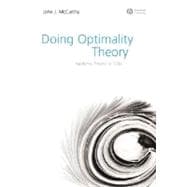
Note: Supplemental materials are not guaranteed with Rental or Used book purchases.
Purchase Benefits
What is included with this book?
| An Introduction to Optimality Theory | |
| How OT Began | |
| Why must Constraints Be Violable? | |
| The Nature of Constraints in OT | |
| Candidate Sets: OT's Gen Component | |
| Candidate Evaluation: OT's Eval Component | |
| Constraint Activity | |
| Differences Between Languages | |
| The Version of OT Discussed in This Book | |
| Suggestions for Further Reading | |
| Notes | |
| How to Construct an Analysis | |
| Where to Begin | |
| How to Rank Constraints | |
| Working through an Analysis in Phonology | |
| The Limits of Ranking Arguments | |
| Candidates in Ranking Arguments | |
| Harmonic Bounding | |
| Constraints in Ranking Arguments | |
| Inputs in Ranking Arguments | |
| Working through an Analysis in Syntax | |
| Finding and Fixing Problems in an Analysis | |
| Constraint Ranking by Algorithm and Computer | |
| The Logic of Constraint Ranking and Its Uses | |
| Notes | |
| How to Write Up an Analysis | |
| Introduction | |
| How to Organize a Paper | |
| How to Present an OT analysis | |
| The Responsibilities of Good Scholarship | |
| How to Write Clearly | |
| General Advice about Research Topics | |
| Notes | |
| Developing New Constraints | |
| Introduction | |
| When Is It Necessary to Modify Con? | |
| How to Discover a New Constraint | |
| How to Define a New Constraint | |
| Properties of Markedness Constraints | |
| Properties of Faithfulness Constraints | |
| Justifying Constraints | |
| A Classified List of Common Phonological Markedness Constraints | |
| Notes | |
| Language Typology and Universals | |
| Factorial Typology | |
| Languages Universals and How to Explain Them in OT | |
| Investigating the Factorial Typology of a Constraint Set | |
| Using Factorial Typology to Test New Constraints | |
| Factorial Typology When Con Isn't Fully Known | |
| How to Proceed from Typology to Constraints | |
| Notes | |
| Some Current Research Questions | |
| Introduction | |
| How Does a Language Vary? | |
| How Is Language Acquired? | |
| Does OT Need Derivations? | |
| How Is Ungrammaticality Accounted For? | |
| Is Faithfulness Enough? | |
| Notes | |
| Table of Contents provided by Publisher. All Rights Reserved. |
The New copy of this book will include any supplemental materials advertised. Please check the title of the book to determine if it should include any access cards, study guides, lab manuals, CDs, etc.
The Used, Rental and eBook copies of this book are not guaranteed to include any supplemental materials. Typically, only the book itself is included. This is true even if the title states it includes any access cards, study guides, lab manuals, CDs, etc.